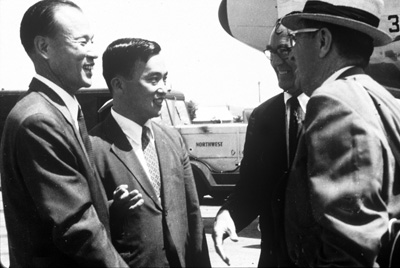This year marks KAIST's 40th anniversary. In commemoration, The KAIST Herald has compiled a short summary of our institution's history. This article uses data and information from KAIST Professor Dong-Won Kim's 1998 paper “Winning Markets of Nobel Prizes? KAIST and the Challenges of Late Industrialization.”
Early Beginnings
In the early 1960s, Korea’s Five Year Plans for economic development were undertaken with the active government-led development of various light and heavy chemical industries. To facilitate this, the Korean government, with the help of American policy advisors, established the Korean Institute of Science and Technology (KIST) in February 1966. This was a research institute geared towards researching areas related to Korea’s export industries: material science, electronics, chemical engineering and mechanical engineering.

Although KIST made several contributions to promoting an interest in research among companies, it could not increase the supply of researchers, as it did no teaching. Thus, for the goals of “education and training of highly qualified scientists and engineers equipped with theoretical and practical expertise,” the Korean Advanced Institute of Science (KAIS) was established in 1971. Following a U.S. model of engineering education, KAIS stressed problem-solving skills and hands-on experience rather than traditional textbook learning. All students were required to master a core curriculum that included statistics, quality control, computer programming and industrial organization and management - all necessary preparation for future industrial leaders.
The Birth of “KAIST”
In 1981, the government merged KAIS and KIST to form the Korea Advanced Institute of Science and Technology (KAIST). The institute kept the new name even after KIST again became an independent organization. Although KAIST’s research projects developed in technological complexity and steadily grew in scale in time with the Korean economy, they never lost their essential industrial character.
However, the common moniker could not conceal the differences between KAIS and KIST. The rapid growth of independent research and development (R&D) facilities during the 1980s deprived KIST of its industrial focus. Also, because KIST had a ratio of engineers to scientists of nine to one, the merger threatened to undermine the delicate balance of theory and practice within KAIST. This was little improved by the resulting confusion from the government’s decision to instate an undergraduate department in 1989.
The Move to Daedeok Science Town
What may have saved both KIST and KAIST was the government's decision to establish a new “science city” in Daejeon, around 140 kilometers south of Seoul. KAIST, needing space and continued governmental support, relocated from its old location in Northeastern Seoul to a new campus in the heart of the “Daedeok Science Town” in 1990. This prompted numerous laboratories and companies to move there afterwards.
By the late 1980s, KAIST had established an education/research system for bachelor’s, master’s and doctoral degrees. KAIST performed its duty well; of the numerous KAIST graduates, the largest percentage moved on to make valuable contributions to the Korean industry. The surge of Korea’s semiconductor, automobile and chemical industries during the 1980s and 1990s should be greatly credited to both the KAIST graduates and professors. Moreover, the “can do” attitude unique to KAIST gave birth to the Korean venture industry in the early 1980s; Qnix, Madison, Turbotech and NHN are just a few of the well-known venture companies founded by KAIST graduates. KAIST’s contribution to the development of Korea’s science and technology and the improvement of its international competitiveness is well-recorded in the annals of Korea’s miraculous economic development.
Of course, KAIST set high standards to maintain quality. Doctoral candidates had to publish some part of their thesis in a referred international journal. Even master's students had to complete a thesis requiring independent research and experimentation, a genuine innovation in an educational system that was founded on textbook examinations. While these rules sparked some bitter criticism within and outside of KAIST, they provided important benchmarks for graduate student research. Student foreign-language publications rose from 21 in 1979 to 178 in 1989 and to 407 in 1996. KAIST expected no less from its faculty; in 1979, its researchers published 122 papers, 45 of them in foreign journals. By 1989 they had pushed the total to 807 papers, with 481 in foreign journals. In 1996 the KAIST faculty collectively published 2,152 papers, with 1,498 in foreign journals.
The 1990s: Expansion
In 1992, KAIST invited the Accreditation Board for Engineering and Technology (ABET), which certifies all U.S. academic programs, to evaluate KAIST. KAIST generally earned high marks, especially for its research and graduate programs. The ABET panel judged several departments, including mechanical engineering ("a top quality, world class program"), chemical engineering ("probably ranking among the top 10 percent of chemical engineering graduate programs worldwide") and material science ("would rank among the top five in the United States in terms of research activity and degrees awarded annually") on par with the best programs anywhere in the world. It called the electrical engineering department a "national treasure." "With an increase in government support," the panel concluded, "KAIST has the potential for becoming one of the top institutions worldwide."

The 2000s and Beyond
While serving as an engine for Korea’s industrial development, KAIST has since adopted a unique, autonomous and flexible academic system. For example, KAIST has recruited students on the basis of their high-school records, math and science grades, teacher recommendations, study plans, personal statements and other data that demonstrate excellence in potential students instead of scores from the state-run scholastic ability test. Its “open major system” allows undergraduate students to take classes for three terms before declaring a major. KAIST has produced many young doctors in their 20s through the Integrated Master’s and Doctoral Program and Early Completion System. Furthermore, with the inauguration of Dr. Nam Pyo Suh as president in July 2006, KAIST launched a number of ambitious reforms designed to enable KAIST to join the ranks of the world’s top 10 universities by the year 2011.

